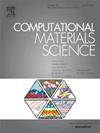Influence of defect and doping on the sensitivity and adsorption capacity of Zr2CO2 toward PH3 gas
IF 3.1
3区 材料科学
Q2 MATERIALS SCIENCE, MULTIDISCIPLINARY
引用次数: 0
Abstract
In this study, the potential application of the ZrCO-MXene structures as PH sensors and adsorbents for industrial or living applications was investigated using the first-principles approach of density functional theory (DFT). The adsorption of PH on pristine, O-defected, and transition metal (TM; such as Cr, Mn, Fe, Co, Y, Mo, Ru, Rh)-doped ZrCO structures was explored. The results showed that the introduction of TM dopant improved the ZrCO activity more than the O-vacancy. The large adsorption energy, short interaction distance, and high charge transfer suggested chemisorption of PH molecules on TM-doped ZrCO. After the PH molecule was adsorbed, the band gap of ZrCO with O-vacancies, Co-doped ZrCO, and Ru-doped ZrCO decreased by 0.132 eV, and increased by 0.065 eV, 0.073 eV, respectively. The changes in band gap generated an electrical signal that were used for PH detection; thus, ZrCO with O-vacancies and Co– and Ru-doped ZrCO can be used as effective PH sensors because of their high sensitivity. Fe- and Rh-doped ZrCO also showed promising function as adsorbents for PH gas molecules because of their high adsorption stabilities and long recovery times. After adsorption of six PH molecules, their adsorption energies on Fe- and Rh-doped ZrCO were −1.142 eV and −1.135 eV, with recovery times of 1.49 × 10 s and 1.12 × 10 s, respectively. The findings of this study offer novel insights for the development of MXene-based sensors and adsorbents.缺陷和掺杂对 Zr2CO2 对 PH3 气体的敏感性和吸附能力的影响
本研究采用密度泛函理论(DFT)的第一原理方法研究了 ZrCO-MXene 结构作为 PH 传感器和吸附剂在工业或生活应用中的潜在应用。研究探讨了 PH 在原始、O-缺陷和过渡金属(TM,如 Cr、Mn、Fe、Co、Y、Mo、Ru、Rh)掺杂的 ZrCO 结构上的吸附。结果表明,掺入 TM 比掺入 O 更能提高 ZrCO 的活性。大吸附能、短相互作用距离和高电荷转移表明 PH 分子在 TM 掺杂的 ZrCO 上具有化学吸附作用。吸附 PH 分子后,带 O-空位的 ZrCO、掺 Co 的 ZrCO 和掺 Ru 的 ZrCO 的带隙分别减小了 0.132 eV、增大了 0.065 eV 和 0.073 eV。带隙的变化产生了用于 PH 检测的电信号;因此,具有 O-空位的 ZrCO 以及 Co- 和 Ru 掺杂的 ZrCO 因其高灵敏度可用作有效的 PH 传感器。Fe和Rh掺杂的ZrCO也因其高吸附稳定性和长回收时间而有望成为PH气体分子的吸附剂。吸附六种 PH 气体分子后,它们在 Fe- 和 Rh 掺杂 ZrCO 上的吸附能分别为-1.142 eV 和-1.135 eV,恢复时间分别为 1.49 × 10 s 和 1.12 × 10 s。该研究结果为开发基于 MXene 的传感器和吸附剂提供了新的启示。
本文章由计算机程序翻译,如有差异,请以英文原文为准。
求助全文
约1分钟内获得全文
求助全文
来源期刊

Computational Materials Science
工程技术-材料科学:综合
CiteScore
6.50
自引率
6.10%
发文量
665
审稿时长
26 days
期刊介绍:
The goal of Computational Materials Science is to report on results that provide new or unique insights into, or significantly expand our understanding of, the properties of materials or phenomena associated with their design, synthesis, processing, characterization, and utilization. To be relevant to the journal, the results should be applied or applicable to specific material systems that are discussed within the submission.
文献相关原料
| 公司名称 | 产品信息 | 采购帮参考价格 |
|---|
 求助内容:
求助内容: 应助结果提醒方式:
应助结果提醒方式:


